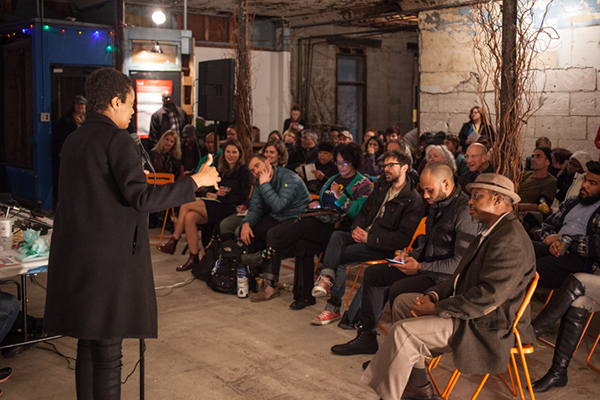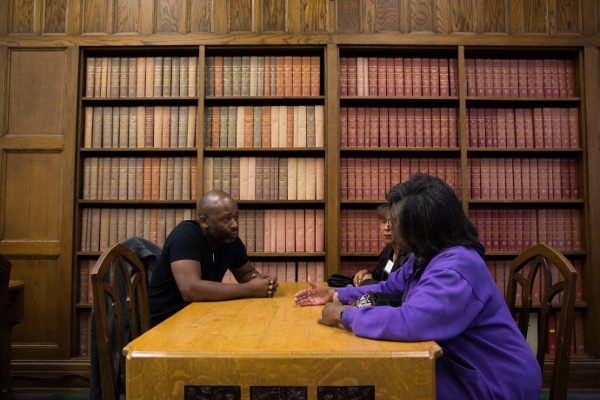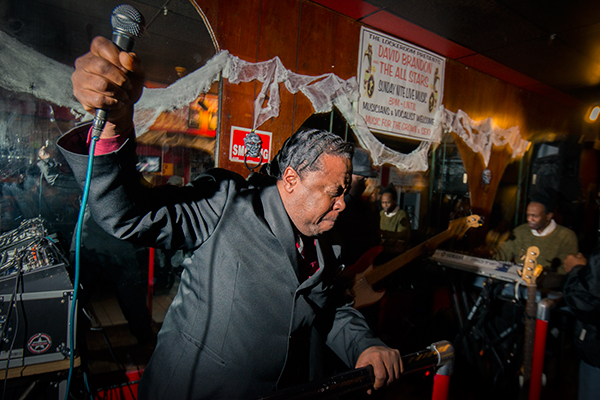Four neighborhoods meet at the intersection of Livernois Avenue and McNichols Road in northwest Detroit. The University District, a collection of some of Detroit's finest brick homes, stands at the intersection's northeast corner, a largely stable and generally well-to-do neighborhood, though some vacant and boarded up homes dot its tree-lined streets. On the other end of the neighborhood-stability spectrum is the Fitzgerald neighborhood, located to the southwest of Livernois/McNichols intersection. A number of Fitzgerald's streets are touched by blight, its wood-frame housing stock marred by abandonment and fire. As with any challenged neighborhood in the city, however, Fitzgerald has its share of residents maintaining their blocks and their homes with pride. In between are the Martin Park and Bagley neighborhoods, to the southeast and northwest, respectively.
Lauren Hood grew up in the Bagley neighborhood, a collection of brick tudors and colonials, its housing stock not dissimilar from the University District, though perhaps slightly less stately. As a teenager and young adult, Hood, like many of her neighbors, would socialize with friends in walkable places outside of the neighborhood, be it downtown Detroit or downtown Royal Oak. While neighborhood institutions like Lou's Deli on McNichols and Eric's I've Been Framed Shop and Gallery on Livernois endure, the Livernois/McNichols commercial corridors have deteriorated, with many of the small businesses leaving and family restaurants being replaced by fast food joints. As the director of the new Live6 initiative, Hood has been tasked with finding ways to re-invigorate the area, both economically and culturally, building upon what's already there with the types of investments residents want.
Created through a partnership of the Kresge Foundation, the Detroit Economic Growth Corporation, and the University of Detroit Mercy, Live6 has been funded to the tune of over $700,000 for two years to help coordinate neighborhood revitalization strategies in its target area—things like placemaking, business attraction and retention, residential stabilization, safety, and security.
Taking its name from the intersection of Livernois and McNichols (referred to colloquially as 6 Mile Road), Live6 is a community development organization not unlike
Midtown Detroit Inc., the nonprofit that facilitates and guides development in Midtown, though Hood says her organization will operate with its own set of philosophies, strategies, and objectives.
U3 Advisors helped develop both organizations around an "eds and meds" strategy, which embraces the idea that a city's anchor institutions—large institutions that employ thousands of people and attract thousands more, such as hospital systems and universities—can be powerful drivers of development.
Like Midtown, the Live6 footprint contains two higher education institutions, University of Detroit Mercy and Marygrove College. Unlike in Midtown, however, the neighborhoods of Live6 are largely made up of single family homes, not apartments and lofts. Hood is very mindful of this distinction as she takes steps to ensure that the Live6 program operates in a way that's true to itself and its target neighborhoods. Her goal is development without displacement.
"You need to be inclusive and be mindful when you are working on new developments that things stay at certain price points—mindful of the kind of developers you're working with and the kind of plans that get put in place so that things can stay attainable for people," she says. "It's tricky. There are some models out there, but I feel like it's got to be unique to this place. There are some things in the works—we'll see. I would like this to be a model to show how to do it in other places, to show that engaging a community early with an organization like this can warrant longer-lasting results than the way people have been doing it."
 A community discussion sponsored by Live6
A community discussion sponsored by Live6
Since her hire three months ago, she's been doing just that, meeting with community residents and stakeholders and gathering their feedback, which can range from enthusiasm to trepidation. Hood has been making herself accessible to the community, understanding that to come in and put in whatever she wants isn't a sustainable approach. She says that the first thing people say they want is a coffee shop, not for fancy coffees and drinks, but for a place to gather. More diversified housing options, not just single family homes but rentable apartments and lofts, could be great for the neighborhood, but they'll be developed with the right price point in mind.
A main strategy Live6 is borrowing from Midtown Inc. is conducting a property parcel inventory and creating a directory to identify the owners and availability of each building in the target area. The group has already identified four properties for redevelopment, one of which is located directly across from UDM on Livernois. Not ready to divulge specifics, Hood says a nonprofit or restaurant could be the first tenant, along with the eventual Live6 offices, and to expect something come spring.
In the meantime, Hood has been organizing placemaking events like pop-ups, open forums, and walking tours to connect the residents, businesses, and colleges with one another. Back in October, Hood worked with the
Van Dusen Urban Leadership Forum at Wayne State University to bring renowned Chicago artist and urban planner Theaster Gates to the Live6 area to give a mobile workshop on community building and inclusive economic development.
 Theaster Gates converses with neighborhood residents in the library of Marygrove College
Theaster Gates converses with neighborhood residents in the library of Marygrove College
Part and parcel with economic development, Hood is hoping to grow the Live6 area as a cultural corridor. She's looking to unearth local history through storytelling events, historic preservation, and identifying signage that will draw out the area's rich heritage. There's a musical legacy in the Live6 district that is often overlooked. The Chessmate coffee shop was once here, a place where 1960s songwriters like Joni Mitchell and Neil Young played. The Locker Room Lounge, a neighborhood bar still open on Livernois, has hosted some of Detroit's best R&B, funk, and soul musicians over the years. And Baker's Keyboard Lounge, while not in the immediate vicinity of the Live6 footprint, is the self-proclaimed world's oldest jazz club. Having opened in 1933, Baker's has hosted the likes of Ella Fitzgerald, Nat King Cole, and Miles Davis, among many, many others.
 David Brandon leads the band at the Locker Room Lounge
David Brandon leads the band at the Locker Room Lounge The stage at Baker's Keyboard Lounge
The need for neighborhood revitalization policy
The stage at Baker's Keyboard Lounge
The need for neighborhood revitalization policy
Frank Rashid is as aware of the challenges the neighborhoods of the Live6 area face as anybody. A resident of the University District, Rashid attended what was then the University of Detroit in the early 1970s, has been teaching at Marygrove College since 1980, and is now the dean of faculty at Marygrove. He's a founding member of the
Institute for Detroit Studies at the college and co-teaches an interdisciplinary course titled Detroit and the Contemporary Urban Crisis that uses the highly-acclaimed "The Origins of the Urban Crisis" by Thomas Sugrue as a foundational text. The book explains that the disinvestment that has occurred in Detroit over the past six or seven decades is a result of structural racism and the federal government subsidizing the movement of white residents from the city to the suburbs in the postwar period.
Rashid remembers a time when there were more places in the neighborhoods where the community could come together. He recalls the Venice Bar on Puritan, a neighborhood joint where faculties from both colleges, faculties from the local public schools, and students and residents of the neighborhoods all congregated. It wasn't that long ago, relatively, but the bar was torn down in the early 1990s, replaced by a parking lot for a funeral home.
Like Hood, Rashid wants to see a day when residents and college students alike are walking down the street together, co-mingling in businesses along a re-invigorated McNichols Road. And like Hood, Rashid believes that for an initiative like Live6 to succeed, the organization will have to listen to residents and work within existing partnerships, rather than trying to impose a vision upon them. There's a role for the colleges in that process, and he says that both Marygrove and UDM have increasingly become more involved in the surrounding communities.
But for all the good Live6 and other community development groups hope to accomplish, Rashid believes that it will ultimately have to be accompanied by policy changes at the top to truly shift course.
"It's policy that drove the abandonment of the city and left a poor population without resources, and policy has to address that. I keep coming back to the fact that, yes, we can do things as anchor institutions—and we can do some wonderful things—but if we're really going to address the fundamental problems that Thomas Sugrue writes about and David Freund writes about in his great book called "Colored Property"—there's a lot of scholarship on this and we know what the problems are—we've got to do something national in scope," says Rashid. "There's quite a bit that has to happen. I'm really interested in what we can do and we want to be as active and as strong as we can but we can't be blind to what the fundamental problems are."
This story is a part of a series of features on the impact of Detroit's anchor institutions. Support for this series is provided by a coalition of organizations, including Henry Ford Health System, Detroit Medical Center, Hudson-Webber Foundation, College for Creative Studies, and Midtown Detroit Inc.
MJ Galbraith is Model D's development news editor. Follow him on Twitter @mikegalbraith.
Photos by Marvin Shaouni, Nick Hagen, Ali Elisabeth Lapetina, and Doug Coombe.